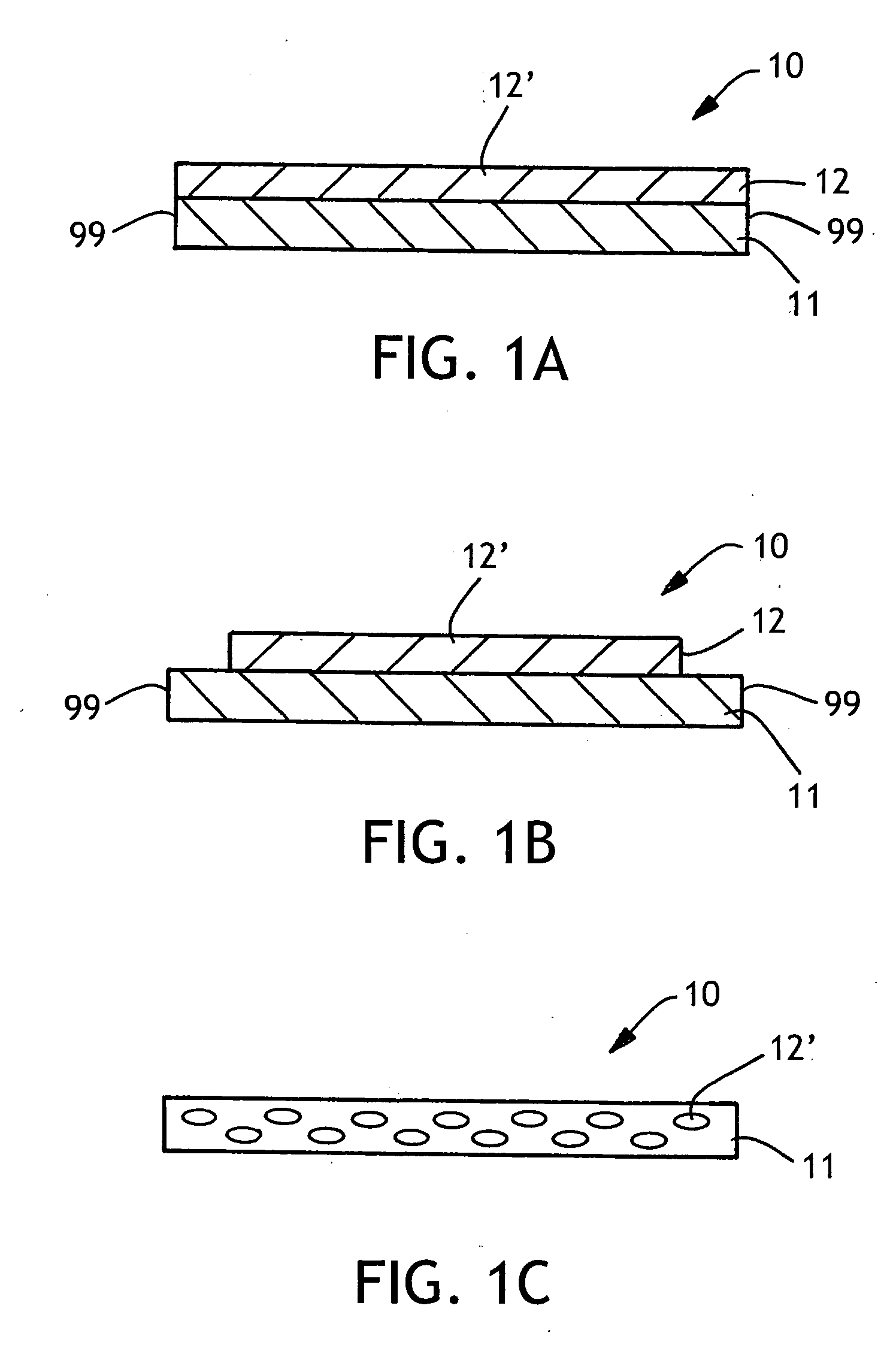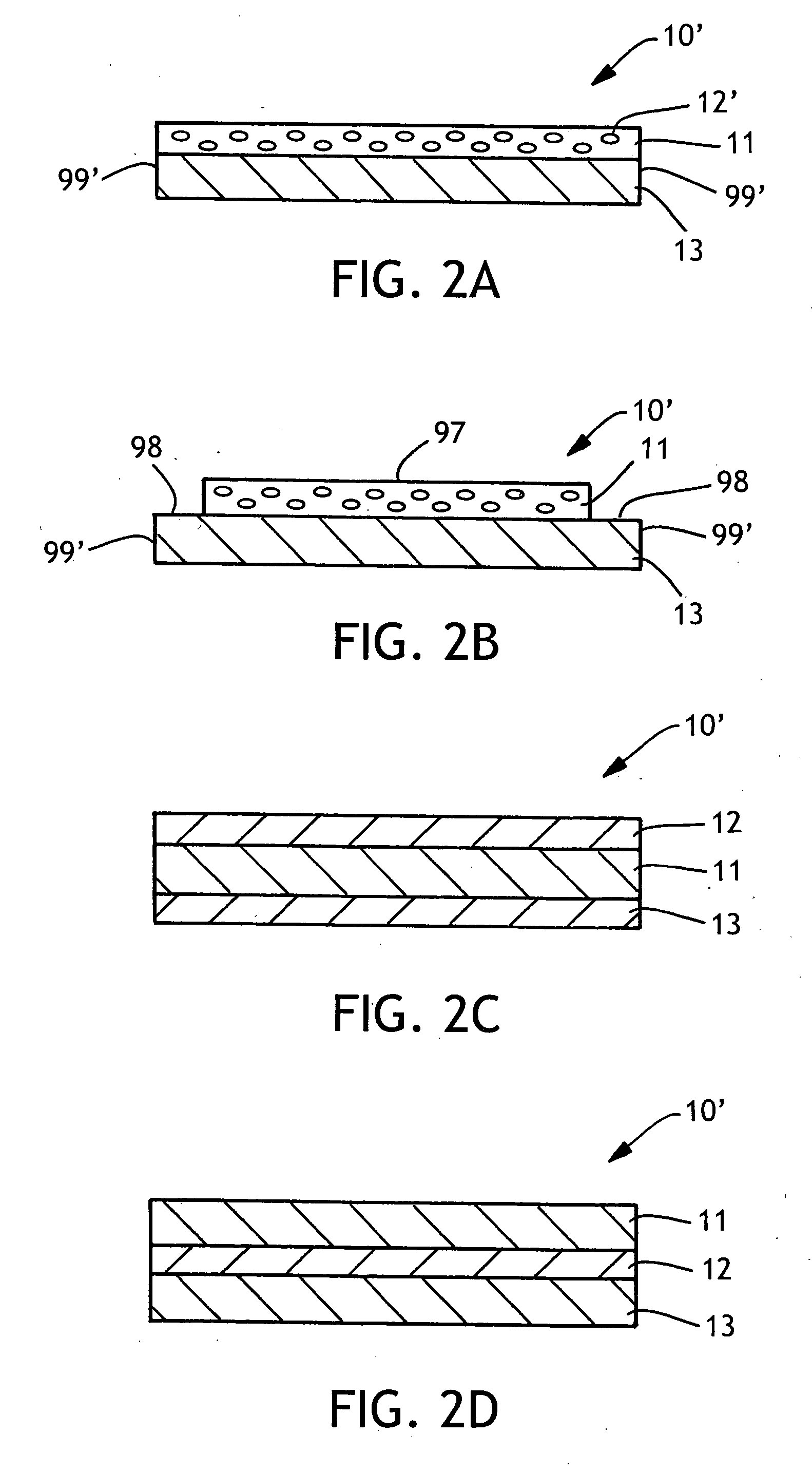Transparent/translucent absorbent composites and articles
a technology of absorbent articles and composites, applied in the field of transparent/translucent absorbent composites and articles, can solve the problems of not being able to meet the color of the wide variety of undergarments currently being manufactured by the clothing industry, unable to meet or nearly match the color of the undergarments, and unable to prepare absorbent articles that match or nearly match the undergarments
- Summary
- Abstract
- Description
- Claims
- Application Information
AI Technical Summary
Problems solved by technology
Method used
Image
Examples
example 1
[0108] Two monomer solutions were prepared separately. Solution No. 1 was prepared as follows: to 237 grams (3.289 moles) of acrylic acid was added to 31.5 grams polyethylene glycol (mol. wt.=200) and 52.6 grams of sodium hydroxide in 350 grams of water (40% neutralization) and 1.5 grams of ascorbic acid. This solution was cooled in an ice bath.
[0109] Solution No. 2 was prepared as follows: 31.5 grams polyethylene glycol (mol. wt.=200) was diluted with 200 g water, then, with rapid stirring was added 5 ml of 3-(trimethoxysilyl)propyl methacrylate(2.7×10−2 moles) to produce a hazy solution. To this solution was added 3.15 g of 30% aqueous hydrogen peroxide.
[0110] A third solution was prepared by dissolving 39.5 grams (0.987 moles) sodium hydroxide in 300 grams of water.
[0111] Solution No. 2 was added to Solution No. 1 in an ice bath while stirring with a magnetic stir bar. A thermocouple was used to monitor the temperature and observe the reaction exotherm. The polymerization reac...
example 2
[0114] Another absorbent article was prepared but instead of placing a single absorbent composite between the backing layer and the bodyside liner, two of the absorbent composites were placed on top of each other between the backing layer and the bodyside liner. As a result a two-layer absorbent composite is used as the absorbent layer. The light transmission of this central region of the absorbent article was tested in accordance with ASTM D-1603, and it was determined that the absorbent article had an average light transmission of 51% (std. dev. 0.5), with an average haze value of 97.8% (std. dev. 1.1) and a clarity of 3.2% (std. dev. 0.5). In the perimeter region of the absorbent article, the average light transmission was 85% (std. dev. 1.6), with an average haze value of 87.5% (std. dev. 2.0) and a clarity of 15% (std. dev. 0.7).
example 3
[0115] The absorbent article of Example 1 was further provided with a transparent film peel strip having a thickness of about 1 mil, available form Tekkote. The peel strip had an average light transmission of 93.7% (std. dev. 0.1), with an average haze value of 51.9% (std. dev. 0.9) and a clarity of 38.8% (std. dev. 0.6). A garment attachment adhesive available from National Starch and Chemical Company under NS-5602 was applied in 7 lines of adhesive at a basis weight of about 30 gsm. The light transmission test was rerun including the peel strip. It was determined that the absorbent article had an average light transmission of 62.4% (std. dev. 1.7), with an average haze value of 97.8% (std. dev. 1.1) and a clarity of 3.2% (std. dev. 0.5). In the perimeter region of the absorbent article, the average light transmission was 75.4 % (std. dev. 2.7)
PUM
| Property | Measurement | Unit |
|---|---|---|
| Fraction | aaaaa | aaaaa |
| Fraction | aaaaa | aaaaa |
| Fraction | aaaaa | aaaaa |
Abstract
Description
Claims
Application Information
 Login to View More
Login to View More - R&D
- Intellectual Property
- Life Sciences
- Materials
- Tech Scout
- Unparalleled Data Quality
- Higher Quality Content
- 60% Fewer Hallucinations
Browse by: Latest US Patents, China's latest patents, Technical Efficacy Thesaurus, Application Domain, Technology Topic, Popular Technical Reports.
© 2025 PatSnap. All rights reserved.Legal|Privacy policy|Modern Slavery Act Transparency Statement|Sitemap|About US| Contact US: help@patsnap.com



